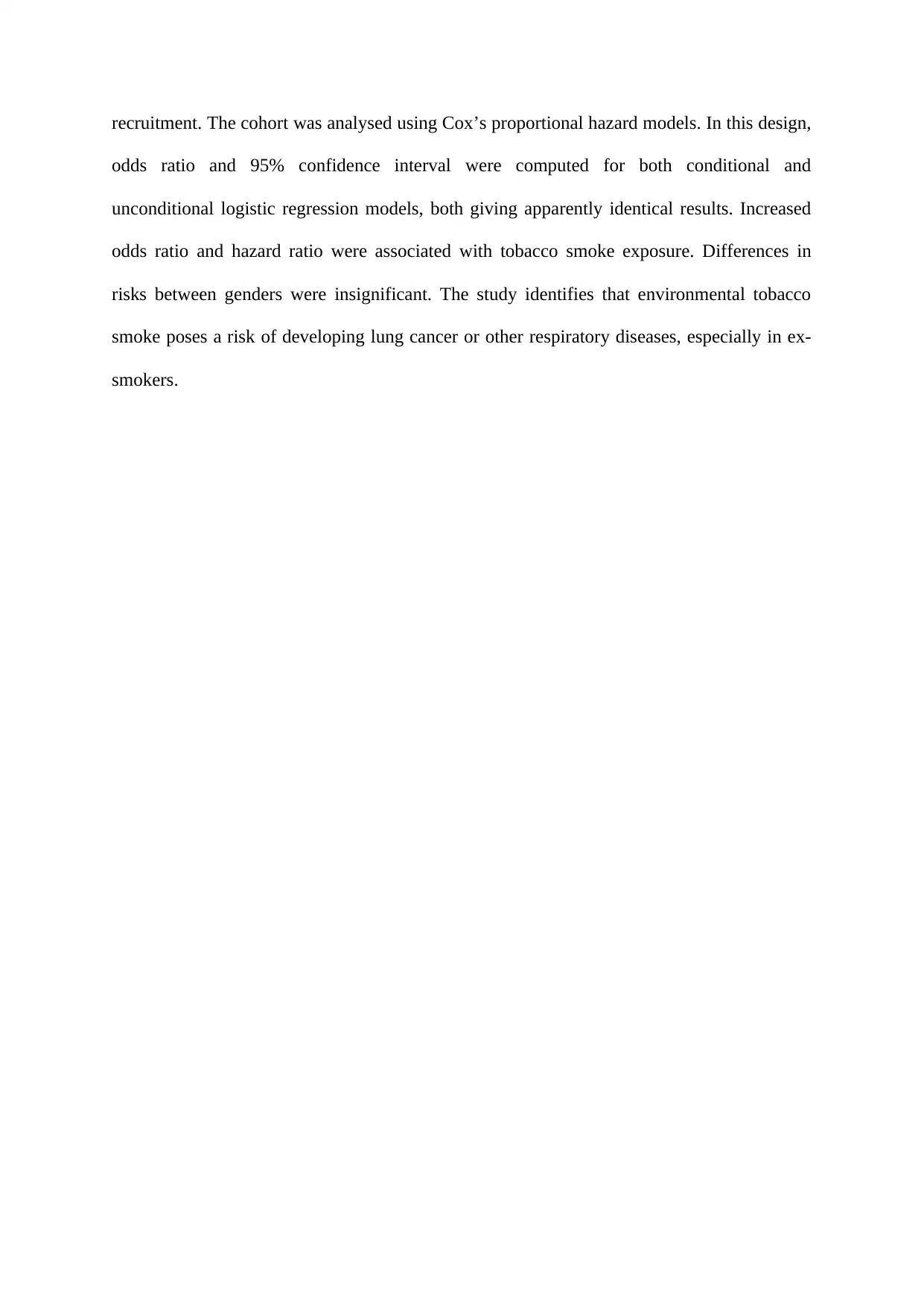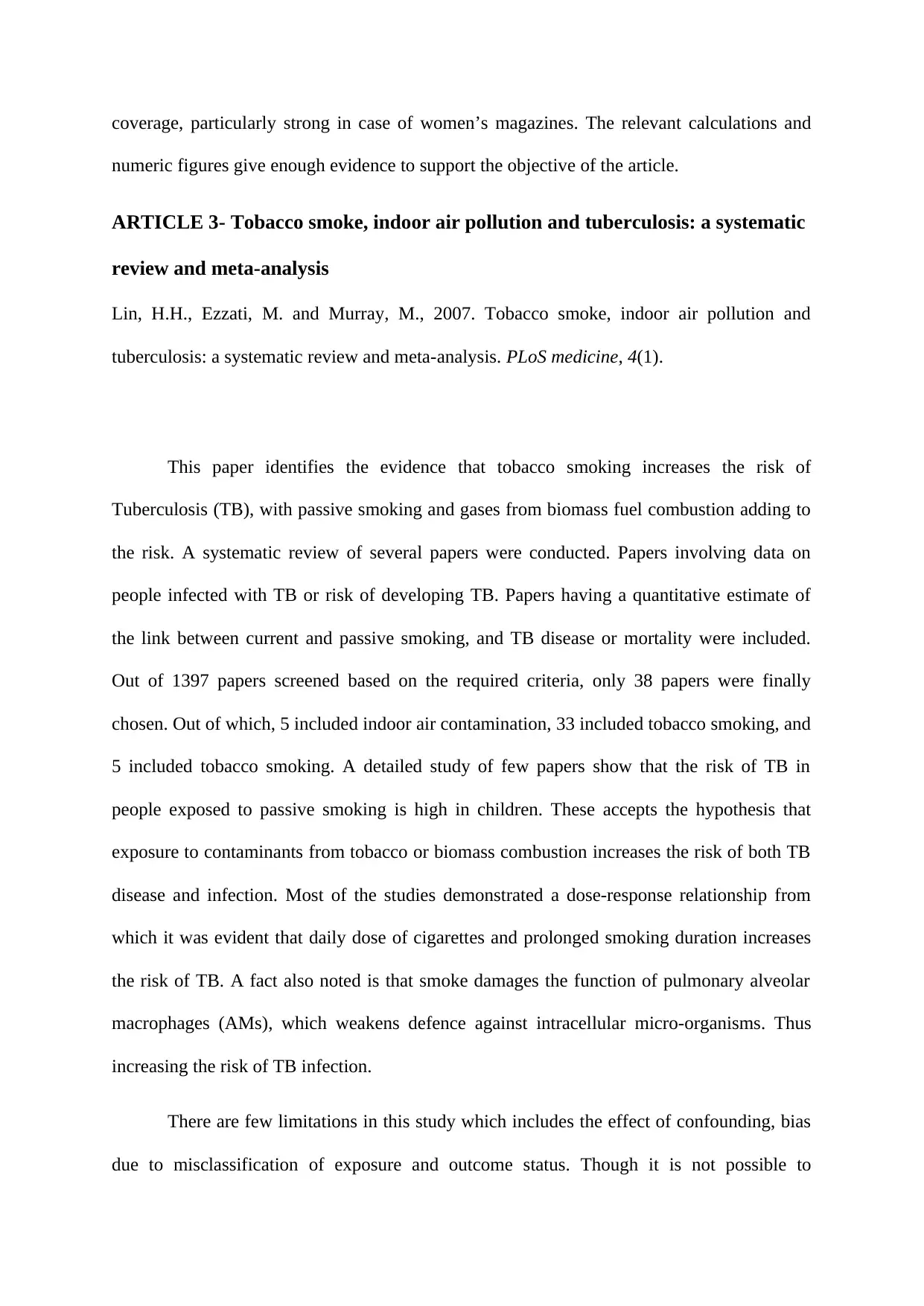HS4005: E-portfolio of Statistics and Data Analysis Activities
VerifiedAdded on 2022/08/29
|7
|1687
|19
Homework Assignment
AI Summary
This assignment analyzes four peer-reviewed articles related to statistical analysis in public health, focusing on the impact of tobacco smoke. The first article investigates the association between environmental tobacco smoke and respiratory cancer and COPD. The second article examines the relationship between cigarette advertising and magazine coverage of smoking hazards. The third article explores the link between tobacco smoke, indoor air pollution, and tuberculosis. The fourth article analyzes changes in mental health after smoking cessation. The assignment fulfills the requirements of an e-portfolio for a statistics in public health course, demonstrating understanding of data interpretation, statistical analysis, and reporting, as well as data management skills. The analysis provides insights into how statistical methods are used to assess the impact of public health interventions and risk factors.

Task 1
ARTICLE 1- Environmental tobacco smoke and risk of respiratory cancer and
chronic obstructive pulmonary disease in former smokers and never smokers in
the EPIC prospective study
Vineis, P., Airoldi, L., Veglia, F., Olgiati, L., Pastorelli, R., Autrup, H., Dunning, A., Garte,
S., Gormally, E., Hainaut, P. and Malaveille, C., 2005. Environmental tobacco smoke and
risk of respiratory cancer and chronic obstructive pulmonary disease in former smokers and
never smokers in the EPIC prospective study. Bmj, 330(7486), p.277.
The purpose of this paper is to find if there exists any association between
environmental tobacco smoke, plasma cotinine concentration, and respiratory cancer or
death. A nested case-control study was conducted on 303,020 volunteers chosen from the
European Prospective Investigation into Cancer (EPIC) cohort. The EPIC cohort consists of
more than 500,000 volunteers selected in 10 European countries, which includes men and
women, preferably within 35 to 74 years. Questionnaires were made to measure diet and
lifestyle of different countries. The participants chosen in this design had never smoked or
had stopped smoking at least 10 years ago. Although, 123479 participants among them gave
evidence of exposure to environmental tobacco smoke.
The proposed design analysed the relation between environmental tobacco smoke and
recently diagnosed cancers of bladder, lungs, oral cavity, pharynx, or larynx, or leukaemia. It
also took into account death due to respiratory diseases. People who were diagnosed with
cancer or died from the above conditions were treated as cases. Three controls were matched
per case, where matching was done for gender, age, smoking status, and months lapsed after
ARTICLE 1- Environmental tobacco smoke and risk of respiratory cancer and
chronic obstructive pulmonary disease in former smokers and never smokers in
the EPIC prospective study
Vineis, P., Airoldi, L., Veglia, F., Olgiati, L., Pastorelli, R., Autrup, H., Dunning, A., Garte,
S., Gormally, E., Hainaut, P. and Malaveille, C., 2005. Environmental tobacco smoke and
risk of respiratory cancer and chronic obstructive pulmonary disease in former smokers and
never smokers in the EPIC prospective study. Bmj, 330(7486), p.277.
The purpose of this paper is to find if there exists any association between
environmental tobacco smoke, plasma cotinine concentration, and respiratory cancer or
death. A nested case-control study was conducted on 303,020 volunteers chosen from the
European Prospective Investigation into Cancer (EPIC) cohort. The EPIC cohort consists of
more than 500,000 volunteers selected in 10 European countries, which includes men and
women, preferably within 35 to 74 years. Questionnaires were made to measure diet and
lifestyle of different countries. The participants chosen in this design had never smoked or
had stopped smoking at least 10 years ago. Although, 123479 participants among them gave
evidence of exposure to environmental tobacco smoke.
The proposed design analysed the relation between environmental tobacco smoke and
recently diagnosed cancers of bladder, lungs, oral cavity, pharynx, or larynx, or leukaemia. It
also took into account death due to respiratory diseases. People who were diagnosed with
cancer or died from the above conditions were treated as cases. Three controls were matched
per case, where matching was done for gender, age, smoking status, and months lapsed after
Paraphrase This Document
Need a fresh take? Get an instant paraphrase of this document with our AI Paraphraser

recruitment. The cohort was analysed using Cox’s proportional hazard models. In this design,
odds ratio and 95% confidence interval were computed for both conditional and
unconditional logistic regression models, both giving apparently identical results. Increased
odds ratio and hazard ratio were associated with tobacco smoke exposure. Differences in
risks between genders were insignificant. The study identifies that environmental tobacco
smoke poses a risk of developing lung cancer or other respiratory diseases, especially in ex-
smokers.
odds ratio and 95% confidence interval were computed for both conditional and
unconditional logistic regression models, both giving apparently identical results. Increased
odds ratio and hazard ratio were associated with tobacco smoke exposure. Differences in
risks between genders were insignificant. The study identifies that environmental tobacco
smoke poses a risk of developing lung cancer or other respiratory diseases, especially in ex-
smokers.

ARTICLE 2- Cigarette advertising and magazine coverage of the hazards of
smoking a statistical analysis
Warner, K.E., Goldenhar, L.M. and McLaughlin, C.G., 1992. Cigarette advertising and
magazine coverage of the hazards of smoking a statistical analysis. New England Journal of
Medicine, 326(5), pp.305-309.
This article focuses on the fact that the magazines that depends on revenues from
cigarette advertisements have lesser chance of publishing articles on hazards of smoking,
with special concern on magazines directed to women. The data was collected on 99 U.S.
magazines for years 1959 to 1986. In this study two hypotheses are considered accounting the
relation between dependence of the magazine on revenue generated from advertising
cigarettes, and the frequency at which the adverse health effects are published. The first
assertion being that acceptance of smoke advertising during a given year was negatively
related to the probability of publishing article on hazard issues. The second hypothesis being,
proportion of advertising revenues obtained from cigarette advertisement was inversely
related to the coverage of hazards. For both cases the dependent variable was set to 1 (if the
article was published in the given year) or 0 (otherwise). Few independent variables were
also added to the model. A logistic regression analysis was conducted to test the validity of
the hypotheses. The fixed effects model was used to confirm the results from the logistic
model. From the 1st analysis, for women’s magazine, presence of cigarette advertisement and
probability of publishing hazards were statistically significant. But significance disappeared
when covariates were included. From 2nd case, the hypothesis was strongly accepted. An 1%
increase in the revenue from cigarette advertisements decreases the probability of risk
smoking a statistical analysis
Warner, K.E., Goldenhar, L.M. and McLaughlin, C.G., 1992. Cigarette advertising and
magazine coverage of the hazards of smoking a statistical analysis. New England Journal of
Medicine, 326(5), pp.305-309.
This article focuses on the fact that the magazines that depends on revenues from
cigarette advertisements have lesser chance of publishing articles on hazards of smoking,
with special concern on magazines directed to women. The data was collected on 99 U.S.
magazines for years 1959 to 1986. In this study two hypotheses are considered accounting the
relation between dependence of the magazine on revenue generated from advertising
cigarettes, and the frequency at which the adverse health effects are published. The first
assertion being that acceptance of smoke advertising during a given year was negatively
related to the probability of publishing article on hazard issues. The second hypothesis being,
proportion of advertising revenues obtained from cigarette advertisement was inversely
related to the coverage of hazards. For both cases the dependent variable was set to 1 (if the
article was published in the given year) or 0 (otherwise). Few independent variables were
also added to the model. A logistic regression analysis was conducted to test the validity of
the hypotheses. The fixed effects model was used to confirm the results from the logistic
model. From the 1st analysis, for women’s magazine, presence of cigarette advertisement and
probability of publishing hazards were statistically significant. But significance disappeared
when covariates were included. From 2nd case, the hypothesis was strongly accepted. An 1%
increase in the revenue from cigarette advertisements decreases the probability of risk
⊘ This is a preview!⊘
Do you want full access?
Subscribe today to unlock all pages.

Trusted by 1+ million students worldwide

coverage, particularly strong in case of women’s magazines. The relevant calculations and
numeric figures give enough evidence to support the objective of the article.
ARTICLE 3- Tobacco smoke, indoor air pollution and tuberculosis: a systematic
review and meta-analysis
Lin, H.H., Ezzati, M. and Murray, M., 2007. Tobacco smoke, indoor air pollution and
tuberculosis: a systematic review and meta-analysis. PLoS medicine, 4(1).
This paper identifies the evidence that tobacco smoking increases the risk of
Tuberculosis (TB), with passive smoking and gases from biomass fuel combustion adding to
the risk. A systematic review of several papers were conducted. Papers involving data on
people infected with TB or risk of developing TB. Papers having a quantitative estimate of
the link between current and passive smoking, and TB disease or mortality were included.
Out of 1397 papers screened based on the required criteria, only 38 papers were finally
chosen. Out of which, 5 included indoor air contamination, 33 included tobacco smoking, and
5 included tobacco smoking. A detailed study of few papers show that the risk of TB in
people exposed to passive smoking is high in children. These accepts the hypothesis that
exposure to contaminants from tobacco or biomass combustion increases the risk of both TB
disease and infection. Most of the studies demonstrated a dose-response relationship from
which it was evident that daily dose of cigarettes and prolonged smoking duration increases
the risk of TB. A fact also noted is that smoke damages the function of pulmonary alveolar
macrophages (AMs), which weakens defence against intracellular micro-organisms. Thus
increasing the risk of TB infection.
There are few limitations in this study which includes the effect of confounding, bias
due to misclassification of exposure and outcome status. Though it is not possible to
numeric figures give enough evidence to support the objective of the article.
ARTICLE 3- Tobacco smoke, indoor air pollution and tuberculosis: a systematic
review and meta-analysis
Lin, H.H., Ezzati, M. and Murray, M., 2007. Tobacco smoke, indoor air pollution and
tuberculosis: a systematic review and meta-analysis. PLoS medicine, 4(1).
This paper identifies the evidence that tobacco smoking increases the risk of
Tuberculosis (TB), with passive smoking and gases from biomass fuel combustion adding to
the risk. A systematic review of several papers were conducted. Papers involving data on
people infected with TB or risk of developing TB. Papers having a quantitative estimate of
the link between current and passive smoking, and TB disease or mortality were included.
Out of 1397 papers screened based on the required criteria, only 38 papers were finally
chosen. Out of which, 5 included indoor air contamination, 33 included tobacco smoking, and
5 included tobacco smoking. A detailed study of few papers show that the risk of TB in
people exposed to passive smoking is high in children. These accepts the hypothesis that
exposure to contaminants from tobacco or biomass combustion increases the risk of both TB
disease and infection. Most of the studies demonstrated a dose-response relationship from
which it was evident that daily dose of cigarettes and prolonged smoking duration increases
the risk of TB. A fact also noted is that smoke damages the function of pulmonary alveolar
macrophages (AMs), which weakens defence against intracellular micro-organisms. Thus
increasing the risk of TB infection.
There are few limitations in this study which includes the effect of confounding, bias
due to misclassification of exposure and outcome status. Though it is not possible to
Paraphrase This Document
Need a fresh take? Get an instant paraphrase of this document with our AI Paraphraser

completely remove bias, adjustments of few factors were made. There is enough evidence
that tobacco smoking, passive smoking and indoor air contamination increases the risk of TB.
ARTICLE 4- Change in mental health after smoking cessation: systematic
review and meta-analysis
Taylor, G., McNeill, A., Girling, A., Farley, A., Lindson-Hawley, N. and Aveyard, P., 2014.
Change in mental health after smoking cessation: systematic review and meta-
analysis. Bmj, 348, p.g1151.
Consumption of tobacco has always been a bane for the human race. Smoking, in
particular, cause millions of deaths each year across the world and costs billions in
healthcare. The object of this project is to analyse the variations in mental health after
quitting smoking to the continuation of smoking. For this systematic review and
observational analysis was chosen. Data and reference lists have been collected from
WebofScience, Cochrane Central Register of Controlled Trials, Medline, Embase, and
PsycINFO. The criteria for the selection of viable studies were based on the mental
assessment of clinically healthy adults, performed before the cessation of smoking (baseline)
and six months after the same. The questionnaire was designed to score an individual based
on their measure of anxiety, stress, depression and other positive and negative psychological
effects on life. These scores were computed again as follow-ups within a range of 7 weeks to
9 years after the baseline analysis. The results show a decreasing curve in several aspects like
depression, anxiety, stress while a significant increase in positive psychological quality of life
between the baseline and follow-ups for the quitters as compared to that of the continuing
smokers. Furthermore, this result was found independent irrespective of the general or
physically/psychiatrically disordered populations. Hence it can be concluded that smoking
that tobacco smoking, passive smoking and indoor air contamination increases the risk of TB.
ARTICLE 4- Change in mental health after smoking cessation: systematic
review and meta-analysis
Taylor, G., McNeill, A., Girling, A., Farley, A., Lindson-Hawley, N. and Aveyard, P., 2014.
Change in mental health after smoking cessation: systematic review and meta-
analysis. Bmj, 348, p.g1151.
Consumption of tobacco has always been a bane for the human race. Smoking, in
particular, cause millions of deaths each year across the world and costs billions in
healthcare. The object of this project is to analyse the variations in mental health after
quitting smoking to the continuation of smoking. For this systematic review and
observational analysis was chosen. Data and reference lists have been collected from
WebofScience, Cochrane Central Register of Controlled Trials, Medline, Embase, and
PsycINFO. The criteria for the selection of viable studies were based on the mental
assessment of clinically healthy adults, performed before the cessation of smoking (baseline)
and six months after the same. The questionnaire was designed to score an individual based
on their measure of anxiety, stress, depression and other positive and negative psychological
effects on life. These scores were computed again as follow-ups within a range of 7 weeks to
9 years after the baseline analysis. The results show a decreasing curve in several aspects like
depression, anxiety, stress while a significant increase in positive psychological quality of life
between the baseline and follow-ups for the quitters as compared to that of the continuing
smokers. Furthermore, this result was found independent irrespective of the general or
physically/psychiatrically disordered populations. Hence it can be concluded that smoking

cessation can result in reduced anxiety, depression and stress and boost the positive quality of
life as compared to those who continue to smoke.
References
Fiorini, T., Musskopf, M.L., Oppermann, R.V. and Susin, C., 2014. Is there a positive effect
of smoking cessation on periodontal health? A systematic review. Journal of
periodontology, 85(1), pp.83-91.
Hughes, J.R., Stead, L.F., Hartmann‐Boyce, J., Cahill, K. and Lancaster, T., 2014.
Antidepressants for smoking cessation. Cochrane database of systematic reviews, (1).
Lin, H.H., Ezzati, M. and Murray, M., 2007. Tobacco smoke, indoor air pollution and
tuberculosis: a systematic review and meta-analysis. PLoS medicine, 4(1).
Taylor, G., McNeill, A., Girling, A., Farley, A., Lindson-Hawley, N. and Aveyard, P., 2014.
Change in mental health after smoking cessation: systematic review and meta-
analysis. Bmj, 348, p.g1151.
Vineis, P., Airoldi, L., Veglia, F., Olgiati, L., Pastorelli, R., Autrup, H., Dunning, A., Garte,
S., Gormally, E., Hainaut, P. and Malaveille, C., 2005. Environmental tobacco smoke and
risk of respiratory cancer and chronic obstructive pulmonary disease in former smokers and
never smokers in the EPIC prospective study. Bmj, 330(7486), p.277.
Warner, K.E., Goldenhar, L.M. and McLaughlin, C.G., 1992. Cigarette advertising and
magazine coverage of the hazards of smoking a statistical analysis. New England Journal of
Medicine, 326(5), pp.305-309.
life as compared to those who continue to smoke.
References
Fiorini, T., Musskopf, M.L., Oppermann, R.V. and Susin, C., 2014. Is there a positive effect
of smoking cessation on periodontal health? A systematic review. Journal of
periodontology, 85(1), pp.83-91.
Hughes, J.R., Stead, L.F., Hartmann‐Boyce, J., Cahill, K. and Lancaster, T., 2014.
Antidepressants for smoking cessation. Cochrane database of systematic reviews, (1).
Lin, H.H., Ezzati, M. and Murray, M., 2007. Tobacco smoke, indoor air pollution and
tuberculosis: a systematic review and meta-analysis. PLoS medicine, 4(1).
Taylor, G., McNeill, A., Girling, A., Farley, A., Lindson-Hawley, N. and Aveyard, P., 2014.
Change in mental health after smoking cessation: systematic review and meta-
analysis. Bmj, 348, p.g1151.
Vineis, P., Airoldi, L., Veglia, F., Olgiati, L., Pastorelli, R., Autrup, H., Dunning, A., Garte,
S., Gormally, E., Hainaut, P. and Malaveille, C., 2005. Environmental tobacco smoke and
risk of respiratory cancer and chronic obstructive pulmonary disease in former smokers and
never smokers in the EPIC prospective study. Bmj, 330(7486), p.277.
Warner, K.E., Goldenhar, L.M. and McLaughlin, C.G., 1992. Cigarette advertising and
magazine coverage of the hazards of smoking a statistical analysis. New England Journal of
Medicine, 326(5), pp.305-309.
⊘ This is a preview!⊘
Do you want full access?
Subscribe today to unlock all pages.

Trusted by 1+ million students worldwide

1 out of 7
Your All-in-One AI-Powered Toolkit for Academic Success.
+13062052269
info@desklib.com
Available 24*7 on WhatsApp / Email
![[object Object]](/_next/static/media/star-bottom.7253800d.svg)
Unlock your academic potential
Copyright © 2020–2025 A2Z Services. All Rights Reserved. Developed and managed by ZUCOL.

